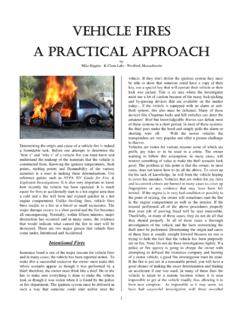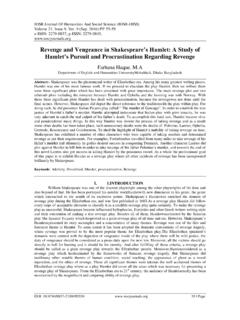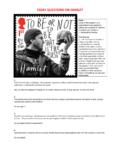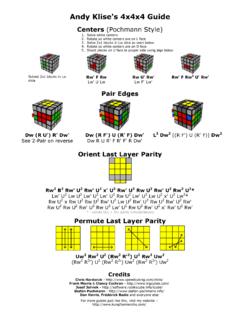Transcription of Reliability, Validity, and Utility of Criminal Profiling ...
1 Journal of Police and Criminal Psychology, 2002, Volume 17, Number 1 1 reliability , validity , and Utility of Criminal Profiling typologies Maurice Godwin Methodist College Criminal Profiling has received attention from the academic community and from the en-tertainment world since the FBI first published accounts of its Profiling principles. It be-came popular through films such as Silence of the Lambs and the X-Files making headlines. However, beyond the victims pin pictures that help create the sensationalism in these resources, there have been few, if any, reliable Criminal Profiling classification designs. This work examines deductive and inductive Profiling models that classify crime scene activity including the first systematic review of the FBI s organized and disorgan-ized Profiling typology.
2 The paper concludes with a discussion about how to turn Profiling from an art too more a scientific process through the use of investigative process man-agement research. INCE ITS EMERGENCE, Criminal Profiling has been given several different terms to describe the technique. For instance, psychological Profiling , Criminal Profiling , Criminal personality Profiling , Criminal investiga-tive analysis, and behavioral evidence Profiling . Regardless, though, of the de-scriptive label applied, Profiling as inves-tigative tool today is entirely intuitive based and represents a less than educated attempt to provide law enforcement agencies with detailed information about the behavior of an unknown individual who has committed a crime.
3 For exam-ple, most published accounts of Profiling , which details the methods employed by various individuals, have tended to take the form of semi-autobiographical books and journalistic articles rather than sys-tematic academic work and, hence, are difficult to evaluate from an accuracy or scientific point of view. As such, the one major flaw of current Profiling methods is that most all profiles emphasizes the various psychological functions that murder has for the offender not what va-rieties of action the murder actually con-sists of. Consequently, these profiles make little distinction between the overt crime scene behaviors as they occur in murders and the psycho-dynamic proc-esses that are taken to account for or produce that behavior.
4 Hence, there is little attempt by profilers to differentiate between aspects of the offender s moti-vations and life-style from aspects of his offending behavior. Another problem, which exist with Profiling , is many pro-filers view Profiling as crime scene re-construction and completely ignore aspects of psychology. Most published accounts that claim new or recent findings in Criminal Profiling are often a part of the cultural baggage past down over the years and S Journal of Police and Criminal Psychology, Volume 17, Number 1 2 are fraught with frailties of human think-ing such as confirmation bias and selec-tive thinking (Holmes, 1996; Turvey, 1999).
5 Current Profiling attempts are predominantly anchored in opinions based on what has already been written or told in the past. On the one hand, some profilers claim that patterns associ-ated with serial offending occur as a re-sult of recognizable mental illness or mental disorder in the offender and these disorders directly relate to and can be classified using a personality theory. On the other hand some profilers attempt to guess at the motive of an offender based on his crime scene actions and refer to this process as behavioral Profiling . However, Profiling from a true behav-ioral approach considers the individual differences between offenses (not of-fenders) by looking at crime scene ac-tions that can be observed rather than guess at the individual s internal work-ings or motivations for the crime.
6 The Origins of the FBI s Criminal Profiling Project The FBI s initial project on serial murder began in 1978 (Ressler, Burgess, & Douglas, 1988). The impetus for the project was to conduct personal inter-views with serial murderers about their crimes in order to find out how they were successful at avoiding capture. The FBI serial murder project was given added attention in Washington, DC in the early 1980s due to public outcry of the murder of a six year old boy in Florida by a se-rial murdered (Ressler, et al., 1988). Therefore, due to public pressure, the FBI serial murder project was brought to the forefront and given the necessary US Government funding, which eventually lead to a unit being established in Quan-tico, Virginia called the Behavioral Sci-ence Unit (BSU) (Ressler, 1988).
7 In 1995 a restructuring phase combined the BSU, Violent Criminal Apprehension Program (VICAP), and the National Center for the Analysis of Violent Crime into one unit, calling it the Critical Inci-dent Response Group (CIRG) (Douglas & Olshaker, 1995). The primary purpose of the serial murder project was to use interviews with convicted killers as a basis for con-structing future classifications, which then could be used to aid police investi-gations. A series of interviews with 36 incarcerated offenders, of whom 25 were defined as serial murderers ( , the kill-ing of three or more individuals over time) took place between 1979 and 1983 in the USA.
8 The interviews were guided by an unstructured checklist of questions. Prior to the interviews, data sources on each offender and his crimes were ob-tained by reviewing crime scene photos, physical and psychiatric reports. How-ever, no detailed analysis of this material has ever been presented. Instead, a sim-ple dichotomy was claimed to emerge from the project by which offenders were classified either as organized or disor-ganized. The assignment of the offend-ers to either the organized or disorganized category was based on the appearance of the victims attire or nu-dity, exposure to the victims sexual parts, insertion of foreign objects in body cavities, or evidence of sexual inter-course.
9 The FBI posits in the literature that the organized and disorganized scheme was developed to classify a sub-group of serial murderers, that is, sex-related mur-ders, where motive was often lacking) (Ressler, 1988). This also can be inter-preted that where the murderer is emo-tional and no organization can be deciphered from his actions at the crime Journal of Police and Criminal Psychology, Volume 17, Number 1 3 scene, there is no motive. Because of the apparent lack of motive, FBI profilers decided to look for evidence of planning, irrationality, or some form of discord at the crime scene to determine whether the offender was organized or disorganized.
10 The organized and disorganized typology is then used to classify the murderer s personality, depending on the category of the crime scene. There are weaknesses in the organ-ized and disorganized dichotomy. For example, there is no explanation in the literature of the differences between the organized and disorganized serial mur-derer. Rather the organized and disor-ganized dichotomy seems to describe the different levels of aggression in serial murderers, although no literature source acknowledges this. The difference in organized and disor-ganized crime scenes are usually ex-plained in the form of a psycho-dynamic drive; the dynamic drives are: 10 re-venge, and 2) sadistic (Ressler, 1988; Lester, 1995).








